2014 FORD FIESTA transmission oil
[x] Cancel search: transmission oilPage 7 of 396

Under Hood Overview - 1.6L
EcoBoost™..................................................181
Engine Oil Dipstick - 1.0L EcoBoost.......182
Engine Oil Dipstick - 1.6L Duratec-16V Ti-VCT (Sigma)
........................................182
Engine Oil Dipstick - 1.6L EcoBoost™.................................................182
Engine Oil Check...........................................182
Engine Coolant Check................................183
Automatic Transmission Fluid Check............................................................185
Brake Fluid Check
.........................................185
Power Steering Fluid Check.....................185
Fuel Filter.........................................................186
Washer Fluid Check.....................................186
Changing the 12V Battery..........................186
Checking the Wiper Blades......................186
Changing the Wiper Blades
.....................186
Changing the Engine Air Filter
..................187
Adjusting the Headlamps.........................188
Removing a Headlamp..............................189
Changing a Bulb - Vehicles With: 4-Door..........................................................190
Changing a Bulb - Vehicles With: 5-Door..........................................................195
Bulb Specification Chart
...........................199
Technical Specifications..........................200
Vehicle Care
Cleaning Products.......................................203
Cleaning the Exterior..................................203
Waxing.............................................................204
Cleaning the Engine...................................204
Cleaning the Windows and Wiper Blades..........................................................205
Cleaning the Interior
...................................205
Repairing Minor Paint Damage
..............206
Cleaning the Instrument Panel and Instrument Cluster Lens.......................206
Cleaning Leather Seats.............................207
Cleaning the Alloy Wheels.......................207 Vehicle Storage
............................................208
Wheels and Tires
General Information
....................................210
Tire Care...........................................................210
Using Winter Tires.......................................224
Using Snow Chains.....................................225
Tire Pressure Monitoring System...........225
Changing a Road Wheel...........................228
Technical Specifications
...........................232
Capacities and Specific- ations
Engine Specifications.................................233
Motorcraft Parts...........................................234
Vehicle Identification Number................235
Vehicle Certification Label.......................235
Transmission Code Designation............236
Accessories
Accessories.....................................................237
Ford Extended Service Plan (ESP)
Ford Extended Service Plan (ESP).......239
Audio System
General Information...................................242
Audio unit - Vehicles With: AM/FM/CD.................................................243
Audio unit - Vehicles With: AM/FM/CD/SYNC...................................247
Audio unit - Vehicles With: Touchscreen Display.........................................................252
Audio unit - Vehicles With: Sony Audio System/Touchscreen Display
.............253
Auxiliary Input Jack.....................................255
Audio Troubleshooting
..............................256
4
Fiesta (CCT) Table of Contents
Page 120 of 396
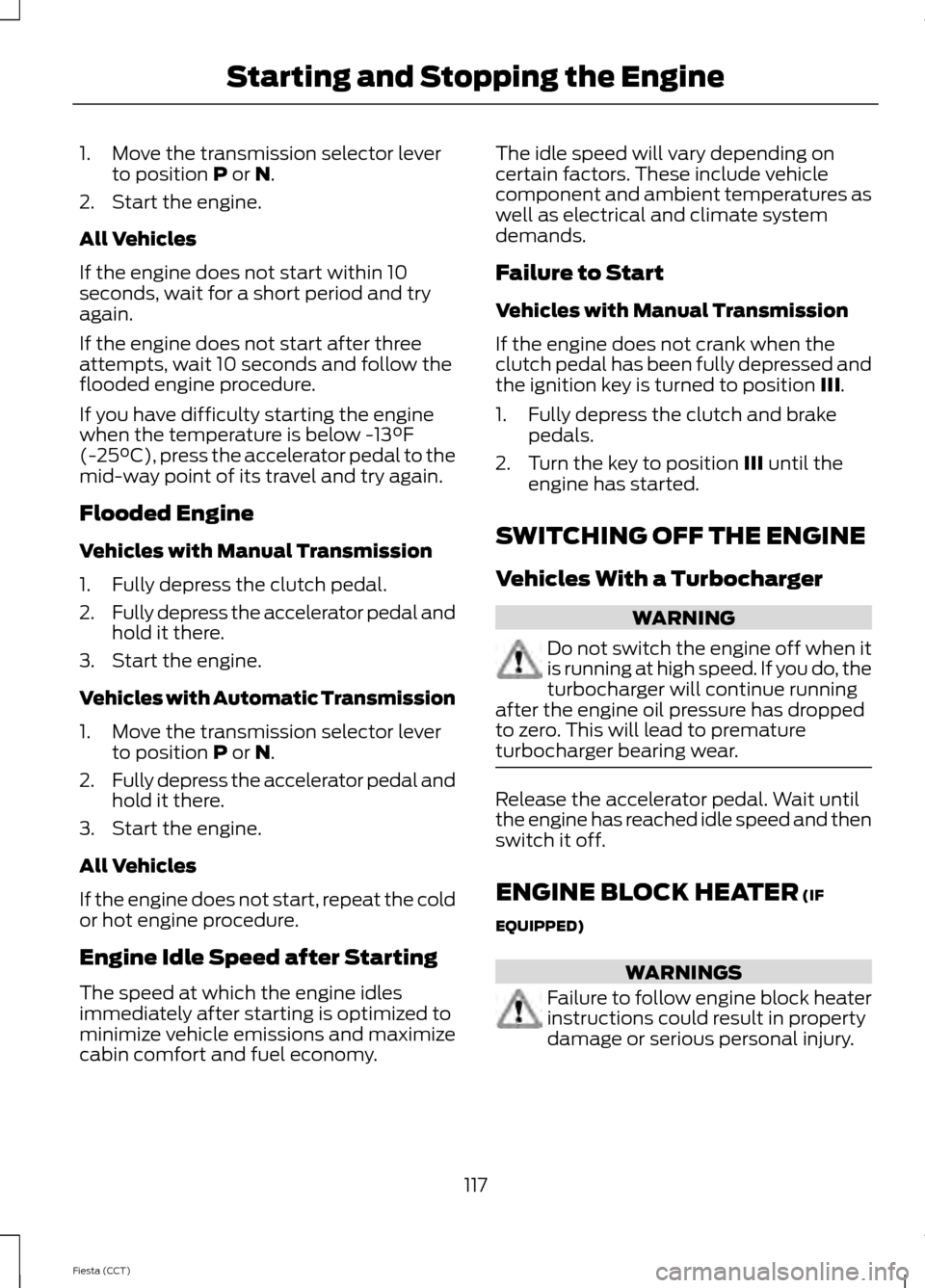
1. Move the transmission selector lever
to position P or N.
2. Start the engine.
All Vehicles
If the engine does not start within 10
seconds, wait for a short period and try
again.
If the engine does not start after three
attempts, wait 10 seconds and follow the
flooded engine procedure.
If you have difficulty starting the engine
when the temperature is below -13°F
(-25°C), press the accelerator pedal to the
mid-way point of its travel and try again.
Flooded Engine
Vehicles with Manual Transmission
1. Fully depress the clutch pedal.
2. Fully depress the accelerator pedal and
hold it there.
3. Start the engine.
Vehicles with Automatic Transmission
1. Move the transmission selector lever to position
P or N.
2. Fully depress the accelerator pedal and
hold it there.
3. Start the engine.
All Vehicles
If the engine does not start, repeat the cold
or hot engine procedure.
Engine Idle Speed after Starting
The speed at which the engine idles
immediately after starting is optimized to
minimize vehicle emissions and maximize
cabin comfort and fuel economy. The idle speed will vary depending on
certain factors. These include vehicle
component and ambient temperatures as
well as electrical and climate system
demands.
Failure to Start
Vehicles with Manual Transmission
If the engine does not crank when the
clutch pedal has been fully depressed and
the ignition key is turned to position
III.
1. Fully depress the clutch and brake pedals.
2. Turn the key to position
III until the
engine has started.
SWITCHING OFF THE ENGINE
Vehicles With a Turbocharger WARNING
Do not switch the engine off when it
is running at high speed. If you do, the
turbocharger will continue running
after the engine oil pressure has dropped
to zero. This will lead to premature
turbocharger bearing wear. Release the accelerator pedal. Wait until
the engine has reached idle speed and then
switch it off.
ENGINE BLOCK HEATER
(IF
EQUIPPED) WARNINGS
Failure to follow engine block heater
instructions could result in property
damage or serious personal injury.
117
Fiesta (CCT) Starting and Stopping the Engine
Page 173 of 396
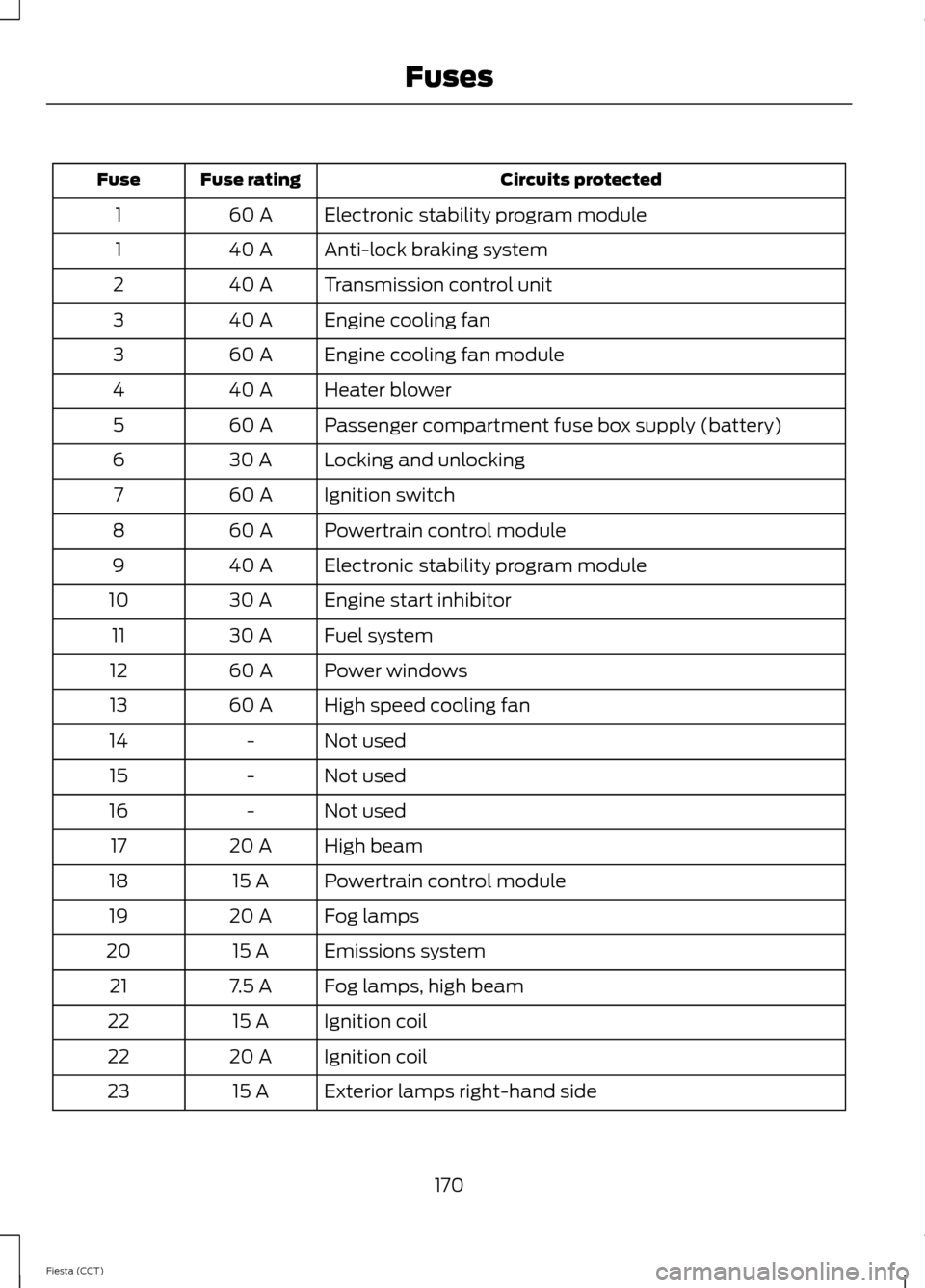
Circuits protected
Fuse rating
Fuse
Electronic stability program module
60 A
1
Anti-lock braking system
40 A
1
Transmission control unit
40 A
2
Engine cooling fan
40 A
3
Engine cooling fan module
60 A
3
Heater blower
40 A
4
Passenger compartment fuse box supply (battery)
60 A
5
Locking and unlocking
30 A
6
Ignition switch
60 A
7
Powertrain control module
60 A
8
Electronic stability program module
40 A
9
Engine start inhibitor
30 A
10
Fuel system
30 A
11
Power windows
60 A
12
High speed cooling fan
60 A
13
Not used
-
14
Not used
-
15
Not used
-
16
High beam
20 A
17
Powertrain control module
15 A
18
Fog lamps
20 A
19
Emissions system
15 A
20
Fog lamps, high beam
7.5 A
21
Ignition coil
15 A
22
Ignition coil
20 A
22
Exterior lamps right-hand side
15 A
23
170
Fiesta (CCT) Fuses
Page 203 of 396
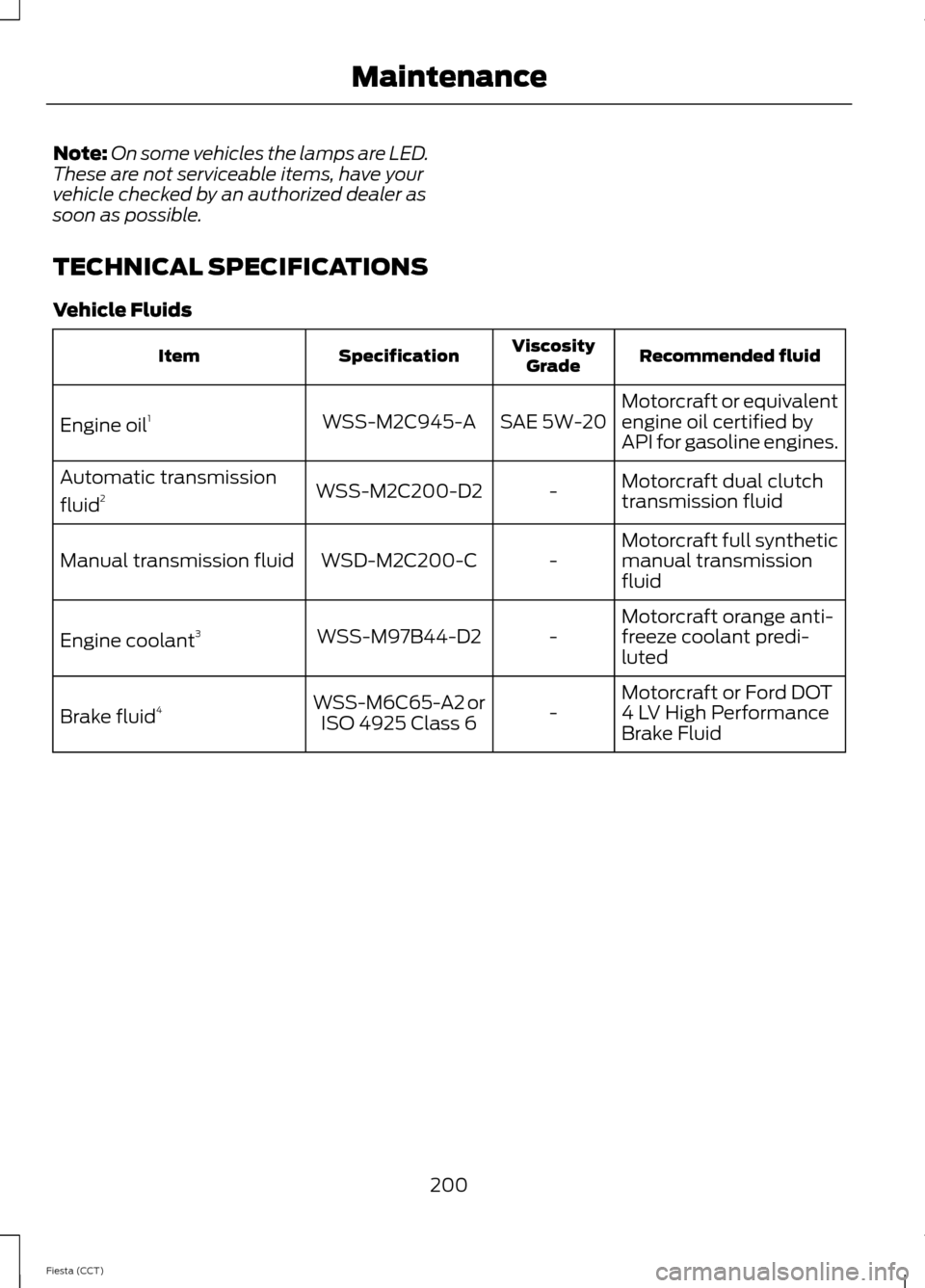
Note:
On some vehicles the lamps are LED.
These are not serviceable items, have your
vehicle checked by an authorized dealer as
soon as possible.
TECHNICAL SPECIFICATIONS
Vehicle Fluids Recommended fluid
Viscosity
Grade
Specification
Item
Motorcraft or equivalent
engine oil certified by
API for gasoline engines.
SAE 5W-20
WSS-M2C945-A
Engine oil 1
Motorcraft dual clutch
transmission fluid
-
WSS-M2C200-D2
Automatic transmission
fluid
2
Motorcraft full synthetic
manual transmission
fluid
-
WSD-M2C200-C
Manual transmission fluid
Motorcraft orange anti-
freeze coolant predi-
luted
-
WSS-M97B44-D2
Engine coolant 3
Motorcraft or Ford DOT
4 LV High Performance
Brake Fluid
-
WSS-M6C65-A2 or
ISO 4925 Class 6
Brake fluid 4
200
Fiesta (CCT) Maintenance
Page 204 of 396

Recommended fluid
Viscosity
Grade
Specification
Item
Multi purpose grease
(Lithium grease)
-
ESB-M1C93-B
Door latch, hood latch,
auxiliary hood latch, trunk
latch, seat tracks
Motorcraft penetrating
and lock lubricant
-
-
Lock cylinder
1 Your engine has been designed to be used with Ford engine oil, which gives a fuel economy
benefit while maintaining the durability of your engine.
Using oils other than the one specified can result in longer engine cranking periods, reduced
engine performance and reduced fuel economy.
2 Automatic transmissions that require Motorcraft MERCON LV transmission fluid should
only use Motorcraft MERCON LV transmission fluid.
Use of any fluid other than the recommended fluid may cause transmission damage.
Change the automatic transmission fluid and filter at the correct service interval. See
Scheduled Maintenance (page 368).
3 Add the coolant type originally used in your vehicle.
4 Use only Motorcraft DOT 4 LV High Performance Brake Fluid, or equivalent, meeting
WSS-M6C65-A2 or ISO 4925 Class 6. Use of any fluid other than the recommended fluid
may cause brake system damage. Capacity
Item
Variant
2.6 qt (2.5 L)
Windshield and rear
window washer system
All
6.1 qt (5.8 L)
Engine cooling
system
All
11.1 gal (42 L)
Fuel tank
1.0L EcoBoost and 1.6L Duratec-16V Ti-
VCT
12.7 gal (48 L)
Fuel tank
1.6L EcoBoost
4.3 qt (4.1 L)
Engine lubrication
system - including the oil filter
All
201
Fiesta (CCT) Maintenance
Page 233 of 396

WARNINGS
Do not attempt to change a tire on
the side of the vehicle close to
moving traffic. Pull far enough off the
road to avoid the danger of being hit when
operating the jack or changing the wheel. Always use the jack provided as
original equipment with your vehicle.
If using a jack other than the one
provided as original equipment with your
vehicle, make sure the jack capacity is
adequate for the vehicle weight, including
any vehicle cargo or modifications. Make sure there is no lubrication
(grease or oil) on the threads or the
surface between the wheel lugs and
nuts. This can cause the lug nuts to loosen
while driving. Note:
Passengers should not remain in the
vehicle when the vehicle is being jacked.
1. Park on a level surface, set the parking
brake and activate the hazard flashers.
2. Place the transmission selector lever in position P (automatic transmission)
or position R (manual transmission)
and turn the engine off.
3. Remove the carpeted wheel cover.
4. Remove the spare tire bolt securing the
spare tire by turning it
counterclockwise.
5. Remove the spare tire from the spare tire compartment. 6. Remove the lug wrench and jack from
the foam holder. 7. Block the diagonally opposite wheel.
8. Loosen each wheel lug nut one-half
turn counterclockwise but do not
remove them until the wheel is raised
off the ground.
Note: Jack at the specified locations to
avoid damage to the vehicle.
9. The vehicle jacking points are shown here, and are depicted on the yellow
warning label on the jack. 230
Fiesta (CCT) Wheels and TiresE142550 E142551 E145908
Page 373 of 396
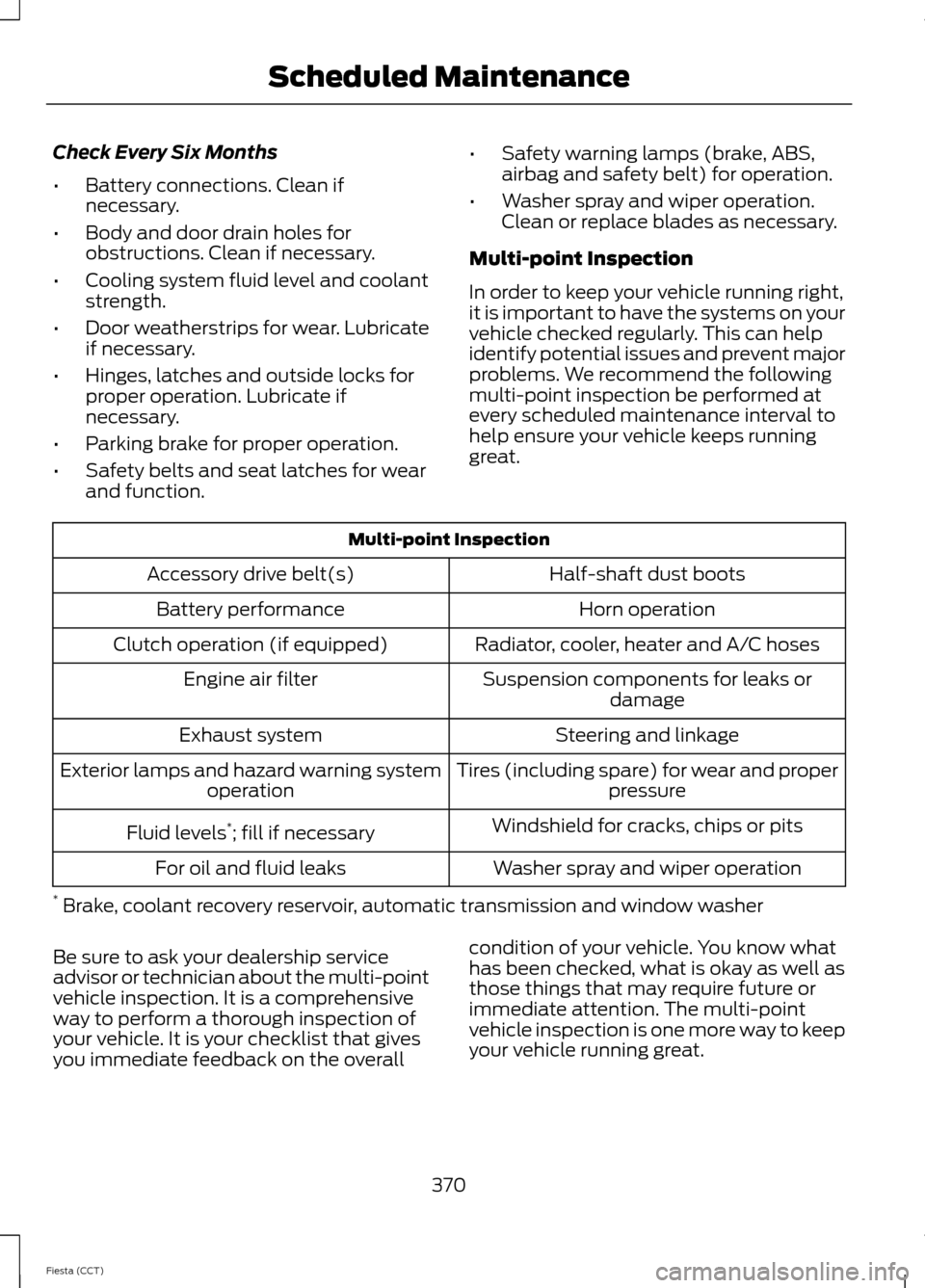
Check Every Six Months
•
Battery connections. Clean if
necessary.
• Body and door drain holes for
obstructions. Clean if necessary.
• Cooling system fluid level and coolant
strength.
• Door weatherstrips for wear. Lubricate
if necessary.
• Hinges, latches and outside locks for
proper operation. Lubricate if
necessary.
• Parking brake for proper operation.
• Safety belts and seat latches for wear
and function. •
Safety warning lamps (brake, ABS,
airbag and safety belt) for operation.
• Washer spray and wiper operation.
Clean or replace blades as necessary.
Multi-point Inspection
In order to keep your vehicle running right,
it is important to have the systems on your
vehicle checked regularly. This can help
identify potential issues and prevent major
problems. We recommend the following
multi-point inspection be performed at
every scheduled maintenance interval to
help ensure your vehicle keeps running
great. Multi-point Inspection
Half-shaft dust boots
Accessory drive belt(s)
Horn operation
Battery performance
Radiator, cooler, heater and A/C hoses
Clutch operation (if equipped)
Suspension components for leaks ordamage
Engine air filter
Steering and linkage
Exhaust system
Tires (including spare) for wear and properpressure
Exterior lamps and hazard warning system
operation
Windshield for cracks, chips or pits
Fluid levels *
; fill if necessary
Washer spray and wiper operation
For oil and fluid leaks
* Brake, coolant recovery reservoir, automatic transmission and window washer
Be sure to ask your dealership service
advisor or technician about the multi-point
vehicle inspection. It is a comprehensive
way to perform a thorough inspection of
your vehicle. It is your checklist that gives
you immediate feedback on the overall condition of your vehicle. You know what
has been checked, what is okay as well as
those things that may require future or
immediate attention. The multi-point
vehicle inspection is one more way to keep
your vehicle running great.
370
Fiesta (CCT) Scheduled Maintenance
Page 374 of 396
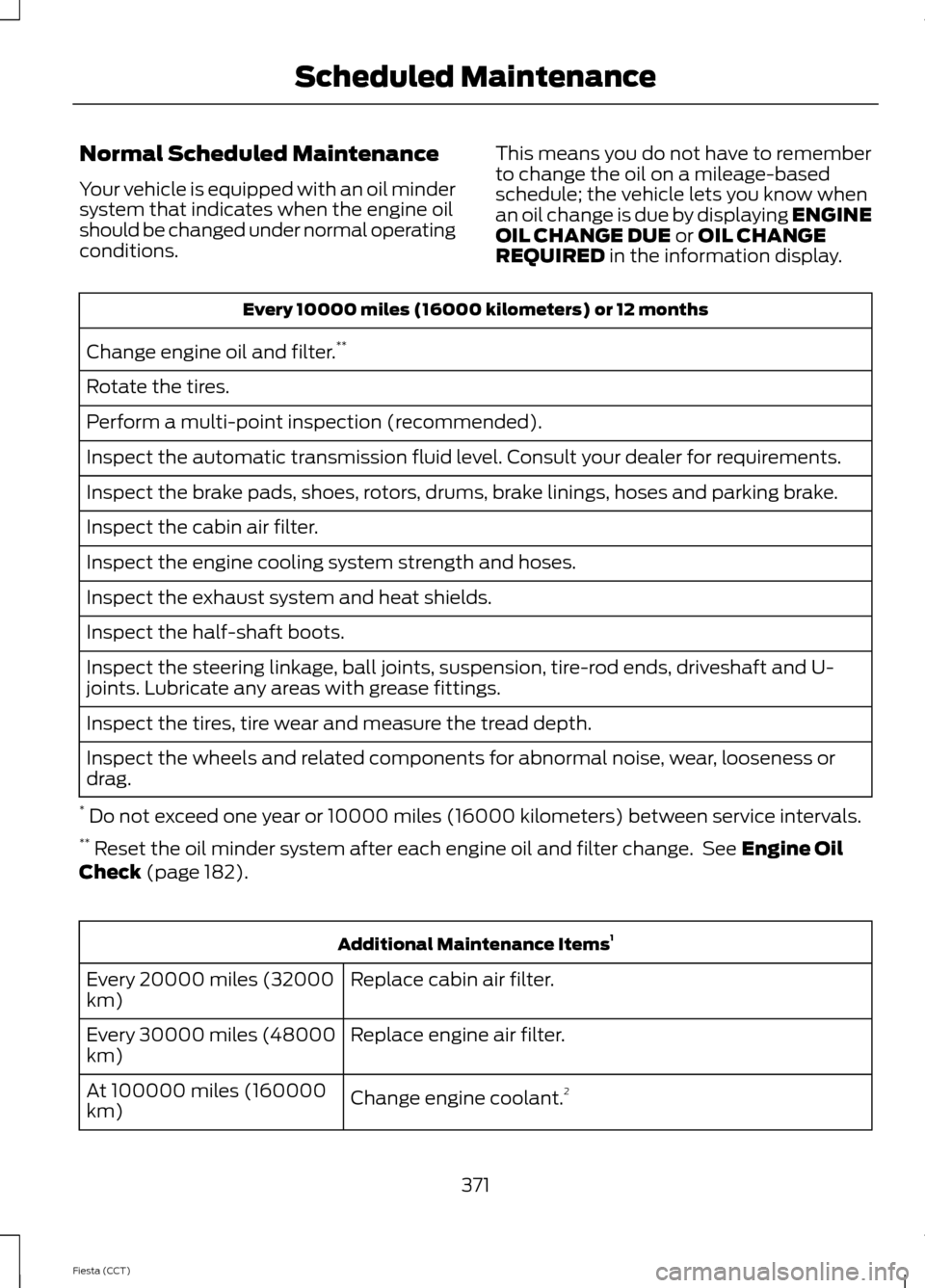
Normal Scheduled Maintenance
Your vehicle is equipped with an oil minder
system that indicates when the engine oil
should be changed under normal operating
conditions.
This means you do not have to remember
to change the oil on a mileage-based
schedule; the vehicle lets you know when
an oil change is due by displaying ENGINE
OIL CHANGE DUE or OIL CHANGE
REQUIRED in the information display. Every 10000 miles (16000 kilometers) or 12 months
Change engine oil and filter. **
Rotate the tires.
Perform a multi-point inspection (recommended).
Inspect the automatic transmission fluid level. Consult your dealer for requirements.
Inspect the brake pads, shoes, rotors, drums, brake linings, hoses and parking brake.
Inspect the cabin air filter.
Inspect the engine cooling system strength and hoses.
Inspect the exhaust system and heat shields.
Inspect the half-shaft boots.
Inspect the steering linkage, ball joints, suspension, tire-rod ends, driveshaft and U-
joints. Lubricate any areas with grease fittings.
Inspect the tires, tire wear and measure the tread depth.
Inspect the wheels and related components for abnormal noise, wear, looseness or
drag.
* Do not exceed one year or 10000 miles (16000 kilometers) between service intervals.
** Reset the oil minder system after each engine oil and filter change. See
Engine Oil
Check (page 182). Additional Maintenance Items
1
Replace cabin air filter.
Every 20000 miles (32000
km)
Replace engine air filter.
Every 30000 miles (48000
km)
Change engine coolant.2
At 100000 miles (160000
km)
371
Fiesta (CCT) Scheduled Maintenance